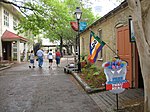Hilton Palacio del Rio

The Hilton Palacio del Rio is a 485-room, 21-story hacienda-style hotel in San Antonio, Texas that opened in 1968. The hotel was constructed for the 1968 World's Fair, HemisFair '68, and was designed by Cerna & Garza Architects. The structure is notable for being a milestone in the use of Modular building construction techniques. Traditional construction methods would not allow the hotel to be completed in the short timeframe available before for the opening of the fair on April 6, 1968, so alternative methods were explored. H.B. Zachry Company utilized traditional construction to build the first 4 floors, slip form construction for the services/elevator core of the building and all guest rooms of the hotel were constructed as modular units in a location 7 miles from the construction site. Modular units were built complete with plumbing fixtures, lighting, art work, furnishings and even ash trays. In a nationally televised event, H.B. Zachry and his wife Molly were the first people to check into and "ride" their hotel room, Room No. 522, into the hotel. All rooms were placed in 46 days and the structure was completed in a record 202 working days with crews working around the clock in staggered shifts. The hotel opened 5 days early on April 1, 1968. The hotel features rich South Texas stylings and original art with the room interiors consisting of five different decor designs executed with custom built furniture and rich fabrics in harmony with the overall theme of royal Spanish living.
Excerpt from the Wikipedia article Hilton Palacio del Rio (License: CC BY-SA 3.0, Authors, Images).Hilton Palacio del Rio
River Walk, San Antonio
Geographical coordinates (GPS) Address External links Nearby Places Show on map
Geographical coordinates (GPS)
| Latitude | Longitude |
|---|---|
| N 29.4224 ° | E -98.4878 ° |
Address
Hilton Palacio del Rio
River Walk
78205 San Antonio
Texas, United States
Open on Google Maps









